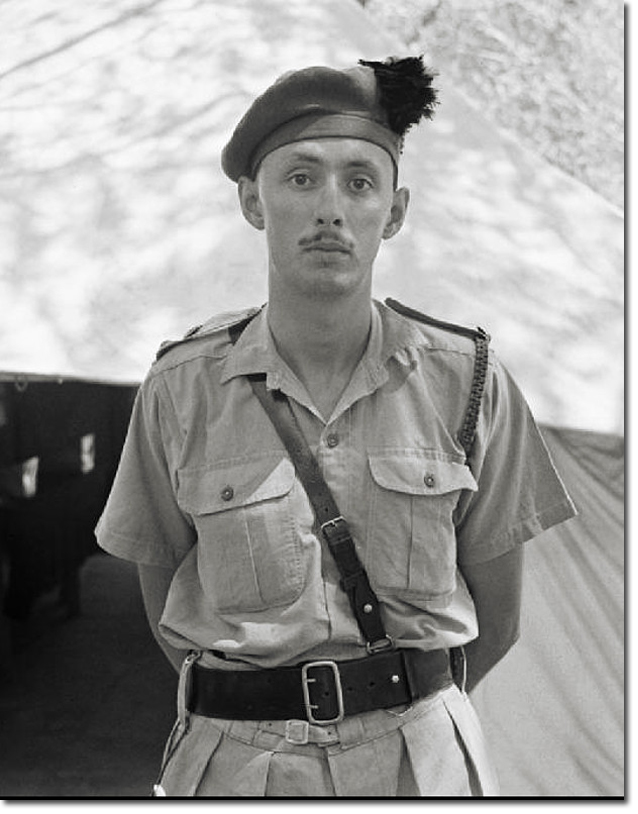|
|


|
|
Geoffrey Charles Tasker Keyes was born on 18 May 1917 in Aberdour, Fifeshire. His father was Rear-Admiral Sir Roger Keyes who was famous for his plan to block the seaward ends of the Bruges ship canal at Zeebrugge on St George's Dy 1918. Young Geoffrey wanted to join the Navy but could not pass the medical, so he went to Sandhurst and was commissioned into his uncle's regiment, the Scots Greys in 1937. He went out to Palestine with the regiment in 1938, and when war broke out volunteered for service in Norway, on the Narvik Expeditionary Force where his skiing skills could be put to use. This was not successful and the expedition was evacuated back to England, but he was decorated with the Croix de Guerre by the Chasseurs Alpin. He next volunteered to join the 11th Scottish Commando and was soon appointed second-in-command with the acting rank of major. They fought in Syria against the Vichy French and he won the MC. He was 24 when he was put in command with the acting rank of lieutenant-colonel.
In North Africa Keyes himself devised the plan to attack Rommel's HQ, 250 miles inside enemy lines, and capture him. It was this suicidal raid in November 1941 that brought about the death of Colonel Keyes and his award of a posthumous VC. It was based on intelligence gathered by Captain Haselden a British officer attached to the Libyan Arab Force. The officer in charge of the commando force in the Middle East was Colonel Laycock who considered the plan reckless and suicidal but it was eventually approved by Major-General Claude Auchinleck. Laycock insisted on going along with them but remaining at the landing place. Haselden's information turned out to be flawed because Rommel had his own villa in Beda Littoria and was living in a house near Gambud. On the night of the raid he was not at the HQ at Sidi Rafa. The plan was to land the commandos from submarines, a force of about 40 men. Unfortunately the weather became worse and the landing was fraught with difficulty. Only half the force managed to get ashore. Leaving Colonel Laycock and the stores near the landing place, they had to advance over a period of three nights and spent the last night in torrential rain. On the evening of 17 November 1941 they blackened their faces and set off at 6pm. One Arab guide absconded and the other had to be threatened by Keyes to point out the German HQ. It was a six storey building with a barbed wire fence around it. Keyes and Sergeant Terry made a recce and came back to organise the attack on the guard tent. This was empty as the guards had taken shelter from the rain in a hut. There was one guard in the doorway who was carefully shot by Keyes so that the sound of the pistol coincided with a thunderclap. The party had enough high explosives to destroy the HQ but it was assumed that the rain would have rendered the fuses useless. Men were detailed off leaving only Keyes, Captain Campbell, Sergeant Terry and three NCOs for the attack on the building itself. The windows were all locked so they had to attempt an entrance by the front door. Campbell spoke German so he knocked and demanded to be let in. When the door was opened, Keyes threatened the soldier with his Colt 45 automatic. A struggle ensued when the soldier grabbed the muzzle of his pistol and Campbell had to shoot the man to stop him shouting. Keyes's arm was numb after the struggle but he tried all the doors that opened onto the hall. They were all empty except one room that had enemy soldiers inside. Keyes ordered a grenade to be tossed in but as he opened the door to do this a German managed to shoot Keyes just over the heart. He fell unconscious as the door was shut and the grenade went off. Campbell and Terry carried him outside and laid him on the grass but he was dead by then. The two men carried on with the raid but Campbell was shot by one of his own commandoes and later had to have his leg amputated. Sergeant Terry, at the age of 19 was now the leader of the expedition. He ordered grenades to be thrown through the windows and explosives used to leave time-bombs. He led the men back across country to the landing place where Colonel Laycock was waiting. They had to wait another day for the submarine to pick them up but during that time they were attacked by a force of Italians and Arabs who captured or killed most of the commandos. Laycock and Sergeant Terry were the only ones to escape. They spent 40 days wandering in the Jebel until they were found by advancing British troops. When Rommel heard of the raid he had the four Germans that were killed and Colonel Keyes buried with military honours. Although the raid was a failure, it caught the imagination of the British public and raised national morale. It also brought the secret commandos to public attention and gave them hero status. More raids followed, with greater success. |
Armed Forces | Art and Culture | Articles | Biographies | Colonies | Discussion | Glossary | Home | Library | Links | Map Room | Sources and Media | Science and Technology | Search | Student Zone | Timelines | TV & Film | Wargames